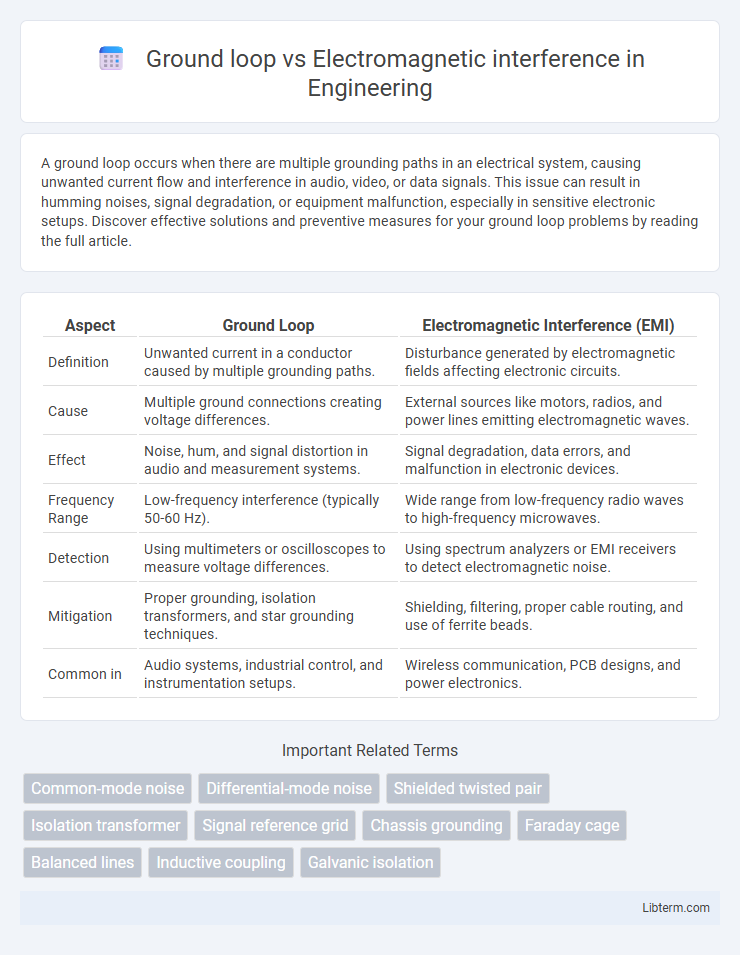A ground loop occurs when there are multiple grounding paths in an electrical system, causing unwanted current flow and interference in audio, video, or data signals. This issue can result in humming noises, signal degradation, or equipment malfunction, especially in sensitive electronic setups. Discover effective solutions and preventive measures for your ground loop problems by reading the full article.
Table of Comparison
| Aspect | Ground Loop | Electromagnetic Interference (EMI) |
|---|---|---|
| Definition | Unwanted current in a conductor caused by multiple grounding paths. | Disturbance generated by electromagnetic fields affecting electronic circuits. |
| Cause | Multiple ground connections creating voltage differences. | External sources like motors, radios, and power lines emitting electromagnetic waves. |
| Effect | Noise, hum, and signal distortion in audio and measurement systems. | Signal degradation, data errors, and malfunction in electronic devices. |
| Frequency Range | Low-frequency interference (typically 50-60 Hz). | Wide range from low-frequency radio waves to high-frequency microwaves. |
| Detection | Using multimeters or oscilloscopes to measure voltage differences. | Using spectrum analyzers or EMI receivers to detect electromagnetic noise. |
| Mitigation | Proper grounding, isolation transformers, and star grounding techniques. | Shielding, filtering, proper cable routing, and use of ferrite beads. |
| Common in | Audio systems, industrial control, and instrumentation setups. | Wireless communication, PCB designs, and power electronics. |
Introduction to Ground Loop and Electromagnetic Interference
Ground loop occurs when multiple paths for electrical current create unwanted noise in audio and video systems, resulting in hum or buzz due to voltage differences between grounding points. Electromagnetic interference (EMI) disrupts signal integrity by inducing unwanted currents from external electromagnetic sources such as radio waves, power lines, or electronic devices. Both ground loops and EMI degrade signal quality but originate from different causes: ground loops stem from improper grounding, while EMI arises from external electromagnetic fields.
Defining Ground Loop Issues
Ground loop issues arise when multiple grounding paths create unintended current flow, causing signal distortions and hum in audio and video systems. These loops occur due to differences in electrical potential between grounding points, leading to interference that degrades system performance. Unlike electromagnetic interference (EMI), which originates from external sources like radio waves or electrical equipment, ground loops are inherently caused by wiring and grounding design faults within the system itself.
Understanding Electromagnetic Interference (EMI)
Electromagnetic Interference (EMI) refers to the disturbance generated by external electromagnetic fields that disrupt the normal operation of electronic devices or communication systems. Ground loop noise occurs when multiple grounding paths create unwanted current flow, leading to hum or buzzing sounds, but EMI encompasses a broader range of interference sources, including radio frequency signals, electrical motors, and fluorescent lights. Understanding EMI involves recognizing how electromagnetic waves induce unwanted currents or voltages in circuits, which can degrade signal integrity and cause data loss or equipment malfunction.
Key Causes of Ground Loops
Ground loops are primarily caused by multiple grounding points creating a difference in electrical potential, leading to unwanted current flow and noise in audio or video signals. In contrast, electromagnetic interference (EMI) originates from external sources such as radio frequencies, electrical devices, or magnetic fields disrupting the signal integrity. Identifying and eliminating inconsistent grounding or potential differences is essential to preventing ground loop issues in electronic systems.
Common Sources of Electromagnetic Interference
Common sources of electromagnetic interference (EMI) include power lines, radio transmitters, fluorescent lights, and electronic devices such as computers and microwave ovens. Ground loops occur when there are multiple grounding paths creating unwanted current, which can amplify EMI effects in audio and video equipment. While ground loops are typically a wiring issue causing hum or noise, EMI originates from external electromagnetic fields disrupting electronic signals.
Comparing Ground Loop and EMI Mechanisms
Ground loops occur when multiple grounding paths create unwanted current flow, causing noise primarily through differences in ground potential. Electromagnetic interference (EMI) arises from external electromagnetic fields inducing unwanted signals in circuits via capacitive or inductive coupling. While ground loops involve actual conductive paths creating low-frequency noise, EMI typically affects systems through radiated high-frequency signals without direct contact.
Effects of Ground Loops vs EMI on Electronic Systems
Ground loops cause unwanted current flow between different grounding points, leading to noise, hum, and signal degradation in audio and video systems. Electromagnetic interference (EMI) disrupts electronic circuits by inducing unwanted voltages or currents through external electromagnetic fields, causing data corruption, reduced system performance, or device malfunction. Ground loop noise typically manifests as low-frequency hum, while EMI can produce a wide range of signal disturbances, affecting sensitive components and communication integrity.
Detection Methods for Ground Loop and EMI Problems
Detection methods for ground loop issues include using a multimeter to measure voltage differences between grounding points and employing clamp meters to identify unexpected current flow in grounding conductors. For electromagnetic interference (EMI), spectrum analyzers and EMI receivers are essential tools that detect and analyze interference frequencies affecting electronic circuits. Differential voltage measurements and frequency scanning are critical techniques to isolate and resolve both ground loop and EMI disturbances in electrical systems.
Prevention and Mitigation Strategies
Ground loop interference can be prevented by ensuring a single-point grounding system and using isolation transformers to break unwanted current paths. Electromagnetic interference (EMI) mitigation involves employing shielded cables, proper grounding of equipment, and installing ferrite beads or EMI filters to suppress noise. Both problems benefit from careful cable routing and maintaining physical separation between power and signal lines to reduce interference risks.
Choosing the Right Solution: Ground Loop vs EMI
Choosing the right solution between ground loop and electromagnetic interference (EMI) issues involves identifying the source of the noise affecting the audio or electronic system. Ground loops typically cause low-frequency hums due to differences in ground potential, solved by isolating ground connections or using ground loop isolators. EMI originates from external electromagnetic fields causing high-frequency noise, mitigated by shielding cables, using ferrite beads, or rerouting cables away from interference sources.
Ground loop Infographic

 libterm.com
libterm.com